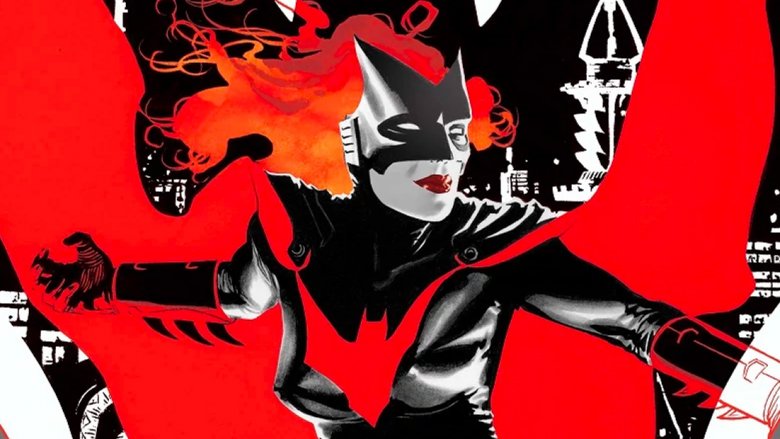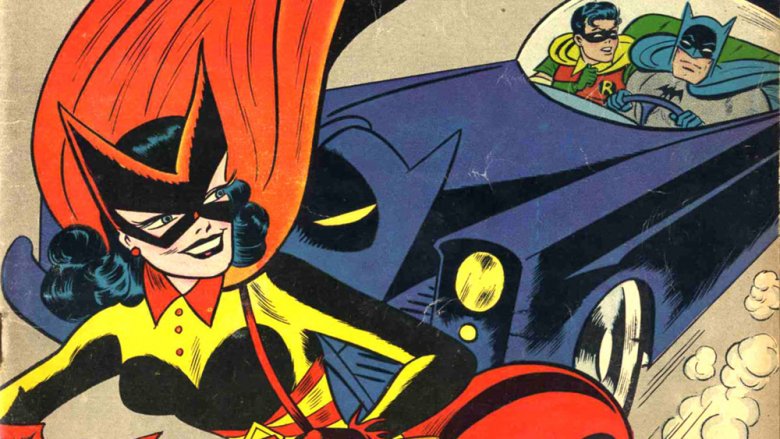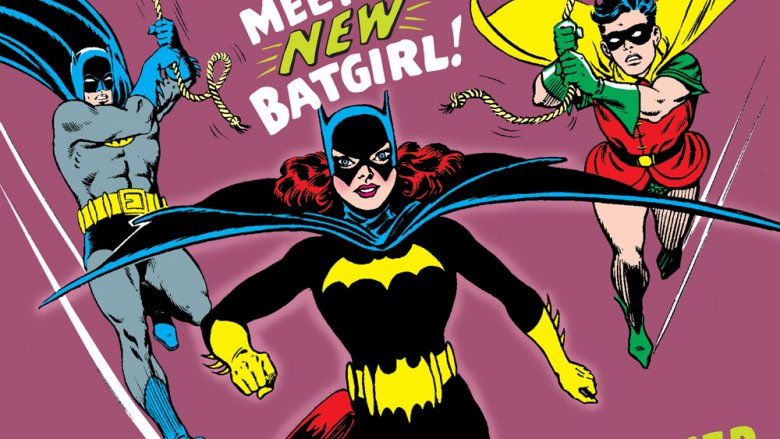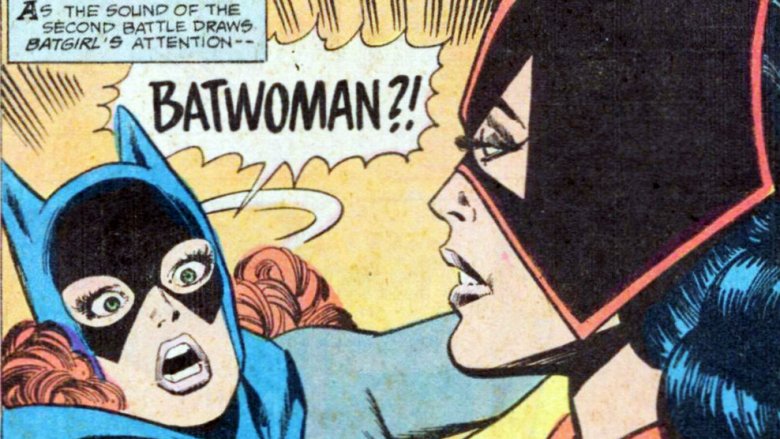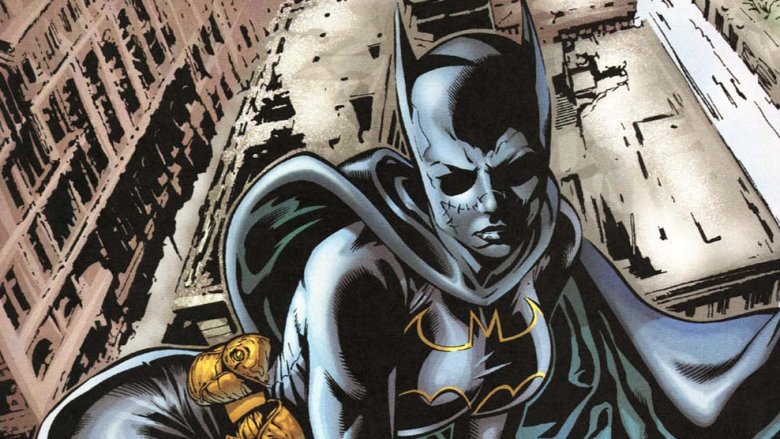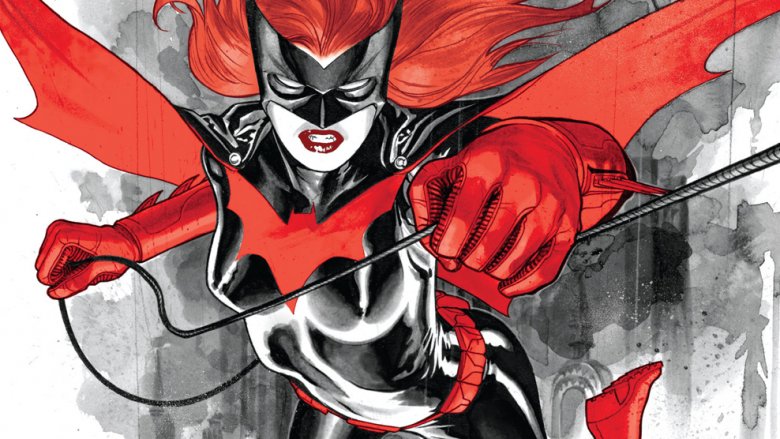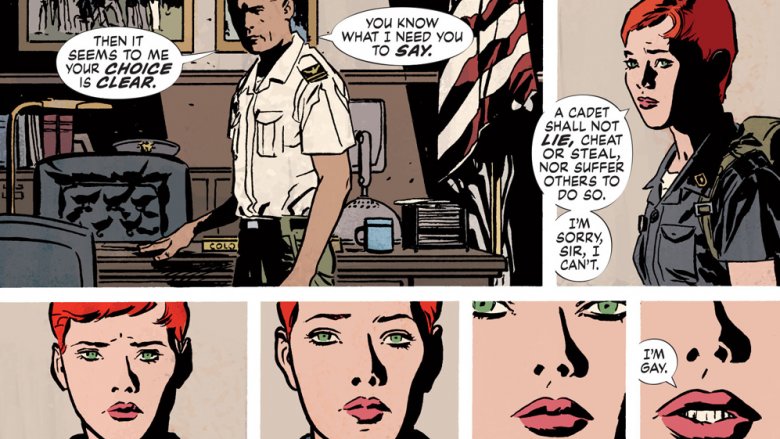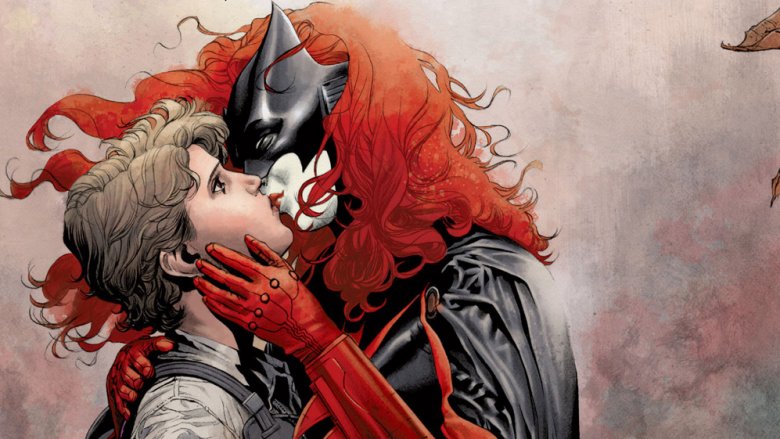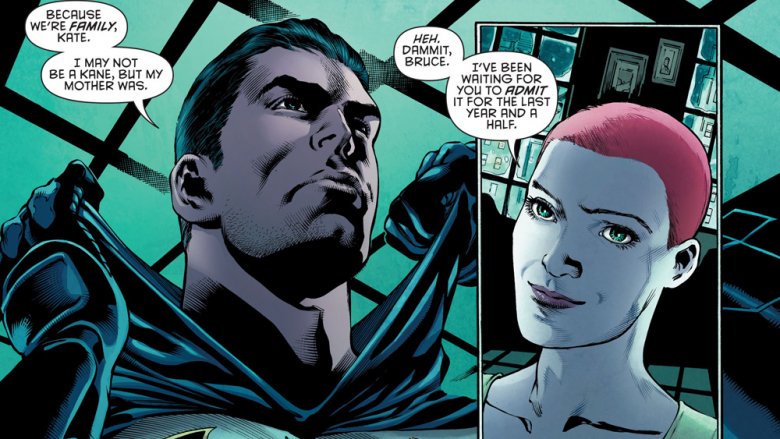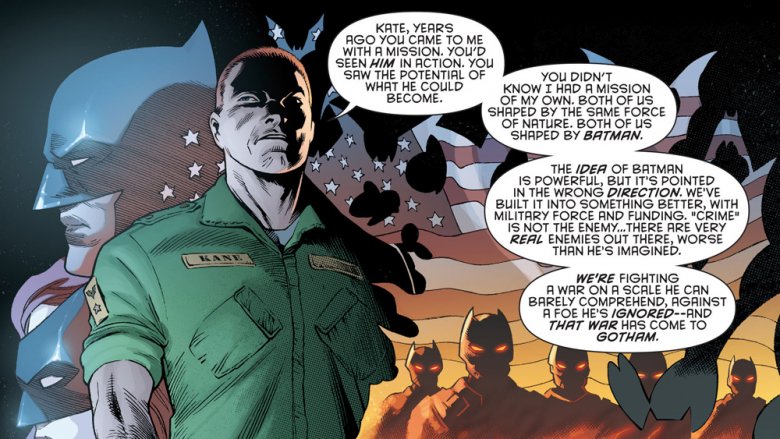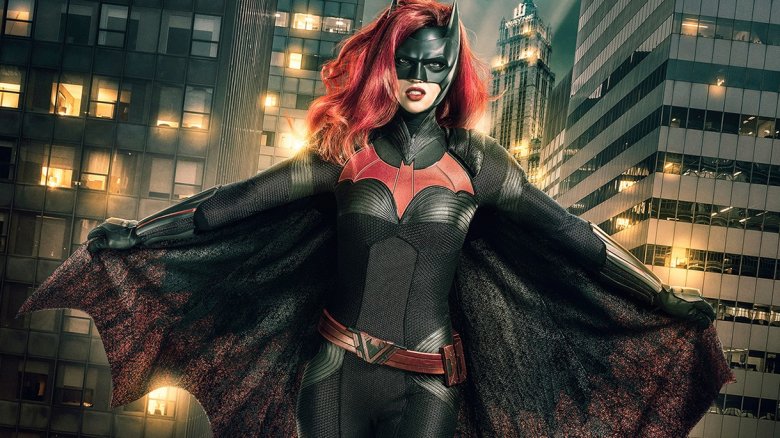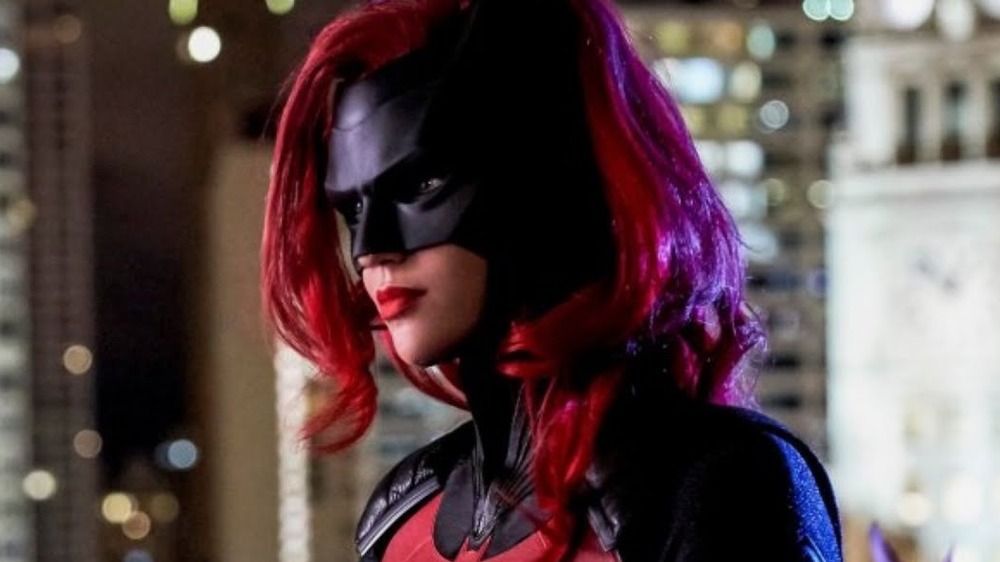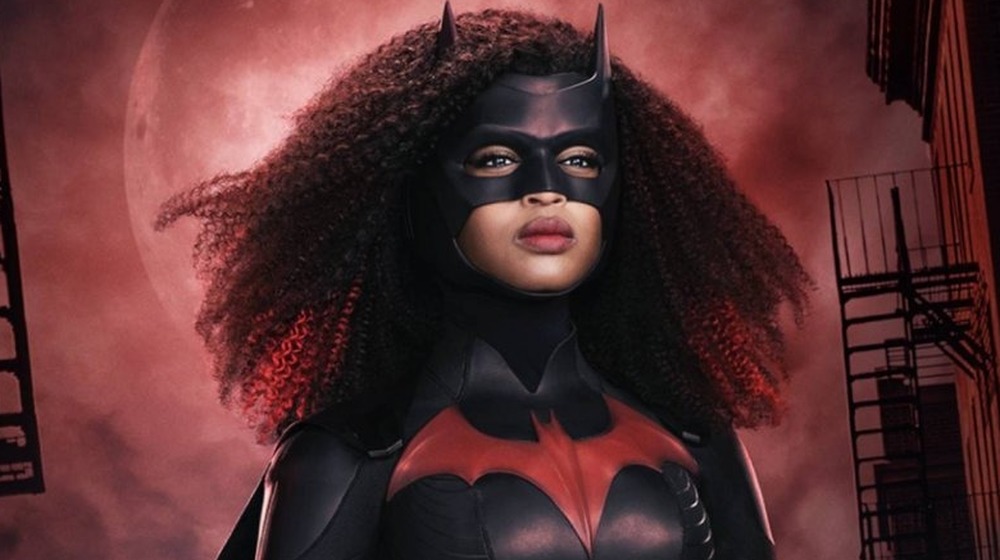The Untold Truth Of Batwoman
While some fans prefer to see him as a lone avenger of the night, Batman's popularity has led the caped crusader into a full-on franchise of characters. Sidekicks like Robin, supporting cast members like Alfred and Commissioner Gordon, and even other heroes based in Gotham City like the Huntress or Hitman have been in the spotlight for decades. Over the past decade, however, none of them have been as important or notable as Batwoman, who is now breaking out of the comic book page and onto the television screen.
The history of Batwoman starts long before Kate Kane donned her black-and-red costume in 2006, however, mirroring the history of comic books themselves. The name and the role of a female equivalent of Batman date back to the controversy surrounding the influence of superheroes in the '50s, and weave through the original Kathy Kane and her successor, Barbara Godon, before winding up with the highest-profile gay character in DC's history. Here's the truth behind Batwoman.
Introducing the Batwoman!
The original Batwoman, Kathy Kane, debuted in 1956, meaning that while this first version didn't have the same staying power, she predated Supergirl by three years. The motivations for introducing a female equivalent to Batman weren't just motivated by a desire to expand the universe. Instead, Kathy Kane's first job after becoming a crimefighter was to take down some scurrilous rumors about the Caped Crusaders.
In his highly dubious and unfortunately influential treatise on the dangers of superhero comics, Seduction of the Innocent, Frederick Wertham posited that Batman and Robin were "a wish dream of two homosexuals living together." Wertham's book would go on to spark full-on congressional hearings and devastate the horror and crime genres, and while superhero titles mostly escaped unscathed, the editors of Batman decided that they needed to restore at least the appearance of heteronormativity to Gotham City. Thus: Kathy Kane, the Batwoman.
As a wealthy socialite and former circus performer whose admiration for Batman drove her to try out a more thrill-seeking brand of crimefighting, Kathy was a love interest in the style of Superman's popular Lois Lane. Bruce Wayne had a thing for her, but she only had eyes for Batman — and to complicate matters, he knew her secret identity, but she didn't know his. The dynamic produced some interesting adventures and even introduced a sidekick in the form of Kathy's niece Betty, the original Bat-Girl, who was a similarly positioned love interest for Robin. In the end, though, Kathy proved to be more popular with readers than she was with incoming Batman editor Julius Schwartz, who pared down the Batman family dramatically when he took over the books in the early '60s.
The million dollar debut of Batgirl
While Kathy Kane was phased out of the comics, the idea of keeping a woman in the Batman family persisted elsewhere — specifically television. In 1967, at the height of the Batman TV show's popularity, producers William Dozier and Lorenzo Semple decided to expand their cast to introduce a new Batgirl. Since comic books have never been shy about capitalizing on the success of their adaptations, which was proven when the Superman franchise imported kryptonite and Jimmy Olsen from the radio show, Schwartz and Carmine Infantino decided to introduce the new Batgirl to the page, too.
Rather than creating someone out of whole cloth, the TV show tied the new Batgirl to an existing character by introducing her as Barbara Gordon, the daughter of Gotham City's solemn and stentorian police commissioner. The viewers (and readers) were clued in on her secret identity, but unlike Kathy Kane, Batman and Robin were initially unaware.
Barbara proved to be incredibly popular, and served as Batgirl until 1988, and then again from 2011 to the present. Even when she wasn't Batgirl, however — thanks to the Joker paralyzing her with a gunshot to the spine in 1988's controversial The Killing Joke — she was popular enough to be featured as Oracle, an incredibly skilled hacker who provided information to Batman and the Justice League.
Batwoman and Batgirl: together at last
When Batman Family launched in 1975, the second issue asked readers to write in with their picks for which secondary Batman characters they wanted to see featured alongside Batgirl and Robin. Apparently, response was strong enough that they featured a reprint of an early Batwoman story in the next issue, and by #3, they were printing letters demanding a return for Kathy Kane.
In #10, the readers finally got their wish when Batwoman came out of retirement for a team-up with her successor, Batgirl. The villains in this issue were Killer Moth and the Cavalier, who teamed up to literally steal the USS Constitution and put it in a giant bottle. Presumably, they had some sort of reason for doing this, but there's a far more important element to the story. By the end of it, Kathy offered Barbara the title of "Batwoman," since Barbara was well into her 20s and a United States Congresswoman at that point. Babs refused, however, claiming that while it was an honor, there was "only one Batwoman."
Soon enough, however, we'd be down to zero. Four years later, in Detective Comics #485, Batwoman was killed by the League of Assassins — specifically by Bronze Tiger, who would go on to be one of the central characters of Suicide Squad and an on-again, off-again ally for Batman. That was the last readers saw of the main universe's Kathy Kane for nearly 30 years, and by the mid-'80s, Crisis on Infinite Earths rearranged the timeline so that she'd never existed at all.
It might be No Man's Land, but Batwoman's No Man
In 1999, Barbara Gordon was Oracle and Kathy Kane had been written out of existence, so there was nothing stopping DC from teasing a potential new Batwoman (or Batgirl) in the pages of the No Man's Land story arc.
In that story, which took up the entirety of 1999 and was spread across every Batman title with tie-ins in other books to boot, Gotham had been devastated by an earthquake and abandoned by the United States government. That left the entire city as a post-apocalyptic ruin that was fought over by gangs led by various supervillains and the holdouts of the GCPD. Since Batman had also been missing for three months after the No Man's Land edict, someone else started wearing a bat costume and claiming territory in his name.
That Batwoman turned out to be the Huntress, but she wasn't the only one to wear the distinctive costume with the stitched-shut mouth. By the end of the story, it was passed to Cassandra Cain, a teenagerwho had been trained since birth to become an assassin. With the Huntress back in her normal identity, Cassandra became the new Batgirl. That was for the best, though, since it left the door open for an all-new Batwoman only a few years later.
The all-new Kate Kane
In 2006, the DC Universe jumped forward by a year, and then explained everything in a year-long weekly miniseries called 52, which somehow needed four extra issues that all came out on the same day. Despite that bit of weirdness, the series set the stage for plenty of major developments, and the most prominent and long-lasting was the introduction of the all-new Batwoman, Kate Kane.
Not to be confused with the Silver Age's Kathy Kane, Kate sported a brand-new black-and-red costume designed by Alex Ross. She also made headlines after she was introduced as DC's highest-profile lesbian character, ever, especially once she took over Detective Comics as its headlining star, which might be ironic given the motives behind the original Batwoman's introduction in 1956.
While she used Batman's iconography in order to strike fear into Gotham City's criminals — particularly the Religion of Crime, which was briefly a big thing back in the late 2000s — Kate was dramatically different from the Caped Crusader. She had military training, was significantly less averse to firearms, and her equivalent to Alfred was her father, a retired general who provided her with experimental military hardware. There was, however, one key similarity: she was driven by seeing her mother and twin sister murdered in front of her, albeit by a terrorist who had kidnapped her rather than a mugger in Crime Alley.
Article 125
In Detective Comics #858, Greg Rucka and J.H. Williams III dove into Kate Kane's origin story, and in the following issue, they dealt with her dismissal from the United States Military Academy during her senior year.
While she was an exceptional soldier, Kate was accused of being in violation of Article 125 of the Uniform Military Code of Justice. For those of you not up on the specifics of martial law, that's the article concerning homosexuality, which was used to keep gay (and bisexual) people out of the military. While she was offered the chance to claim that it was all a misunderstanding, Kate chose to leave West Point and never fulfil her lifelong dream of serving in the Army rather than lie about who she was and what she had done, and that integrity has been one of her defining characteristics ever since.
It's worth noting that this story was originally published in 2009, when the official policy of the military was "Don't Ask, Don't Tell," meaning that gay people could serve, just as long as they were in the closet. Only two years later, in 2011, that policy was changed, and Article 125 was officially repealed from the UCM. That means that eventually, Kate's origin and that defining moment may have to be retconned, in the same way that Marvel's Punisher is now considered too old to be a Vietnam War veteran. Considering that's a fictional retcon that comes at the cost of real-world progress, it's no surprise that the creators of that origin story are absolutely fine with it.
The marriage that wasn't
When DC rebooted their entire line in 2011 as "The New 52," Batwoman got her first ongoing series, co-written by J.H. Williams III and W. Haden Blackman, and as you might expect, they expanded their supporting cast. The most notable addition was Maggie Sawyer, who had first met Kate during her headlining run in Detective Comics, and quickly became her love interest.
Maggie was originally introduced in the Superman books in the '90s as a police officer in the Metropolis Special Crimes Unit. Back then, she was one of the most prominent gay characters in comics, with a major role in the ongoing saga. In the early 2000s, she was transferred to Gotham City's police department in Gotham Central, a book that was not coincidentally co-written by one of Kate's creators, Greg Rucka. The relationship between Maggie and Kate was a huge part of the series, and led to a groundbreaking moment in Batwoman #17, when Kate proposed.
Unfortunately, the marriage never happened. While the book was leading to it for months, editors at DC forbade the wedding from taking place, a controversial decision that prompted Williams and Blackman to leave the book in protest. According to Williams, the decision wasn't made as a result of an anti-LGBT agenda, but rather because of an editorial shift that turned against marriage in general, with publisher Dan DiDio saying that "heroes shouldn't have happy personal lives." It's pretty difficult to buy that explanation when you consider that a few years later, they'd do some complicated continuity gymnastics to bring back the version of Superman who was married to Lois Lane and had a son of his own, but in fairness, DiDio was speaking specifically about the Batman family at the time.
Family tradition
The massive crowd of sidekicks, associates, and hangers-on that surround Gotham City's Dark Knight are often referred to as the Batman Family, but in Batwoman's case, that's not just a team name. Kate Kane is in fact a member of Batman's biological family. It's one of the reasons that he's always trusted her with his symbol, despite the fact that he wasn't part of her training.
If you're up on the complicated in-universe history of Gotham City, you may already know that the Kane family — named for Batman's co-creator, Bob Kane — is one of Gotham's oldest and richest. What you might not know, given that the Wayne name is usually the one that's explored in detail, is that before she got hitched to a handsome doctor named Thomas, Batman's mom was Martha Kane. Her father, Jacob Kane, was Martha's brother, meaning that she's Bruce Wayne's cousin.
That represents a pretty big shift from most modern ideas about Batman. In the Silver Age, the question of who raised Bruce after his parents were killed was answered by the introduction of his uncle Philip, who took custody of young Bruce and brought him on his world-traveling adventures. In the '90s and 2000s, Bruce was meant to have been raised by Alfred, the family butler, a pretty buck wild family situation that we all just sort of accepted. The current version of Batman's origin, however, reintroduced Uncle Phil as Philip Kane, another one of Martha's siblings, once again expanding Bruce and Kate's family tree.
Dad goes bad
From the moment she was introduced, Kate Kane was assisted by her father Jacob. He was essentially her version of Alfred, Oracle, and Lucius Fox rolled into one character, a strategist who provided her with specialized equipment and parsed information on the other side of a communications link. In 2016, however, that all changed.
At the time, Batwoman was once again headlining Detective Comics, leading a team of sidekicks that included Robin, Spoiler, Cassandra Cain, and a reformed Clayface. Their first challenge came in a story called "Rise of the Batmen," in which it was revealed that a rogue faction of the United States military had been training an entire corps of soldiers that were modeled after Batman's methods — minus the aversion to firearms and killing, of course. Their leader? Jacob Kane, who revealed that Kate's career as Batwoman had been a proof of concept for his army of Bat-soldiers.
Needless to say, that put a strain on their relationship. When she was asked to choose between leading an army of ersatz Batmen — which would require her to turn against Bruce and her newfound team — Kate chose instead to stick with the heroes.
Batwoman comes to television
Over a period of years, the CW formed a full-on DC multiverse on television, with a core roster of shows encompassing Flash, Arrow, and Legends of Tomorrow, plus Supergirl and Black Lightning, which exist in their own separate dimensions. In 2017, the "Arrowverse" shows crossed over with Supergirl for "Crisis on Earth-X," an event based on the multiverse team-ups in the comics, and another crossover in 2018 came in the form of "Elseworlds." In addition to existing heroes, The CW used it to launch a new character to DC TV: Batwoman, as portrayed by Ruby Rose, best known for her work in John Wick: Chapter 2 and on Orange Is the New Black. Like Kate Kane, Rose identifies as a member of the LGBTQ community, although she took some heat (and subsequently deleted her Twitter account) for portraying a Jewish character even though she doesn't have that cultural or religious background.
The CW's take on Batwoman exists in a Gotham City where Batman disappeared three years earlier, leading to a surge in crime (and thus the need for a new, bat-themed vigilante crimefighter). The full-fledged Batwoman series, with Rose at the forefront, debuted in September 2019, and halfway through the first season, The CW ordered a second season.
Ruby Rose hung up the cowl
Playing a major comic book character in a popular TV series adaptation could be a career-maker for most any actor, and it looked like Ruby Rose would follow and enjoy that trajectory. However, in May 2020, just a few months after the CW asked for a second season of Batwoman, Rose announced that she would be departing the series. "This was not a decision I made lightly as I have the utmost respect for the cast, crew, and everyone involved with the show," Rose said in a statement (via Variety). "Thank you to everyone who made season one a success — I am truly grateful."
Why would an actor walk away from such a plum role and a regular gig on network television? Variety quoted a source close to the production who said that Rose leaving "had nothing to do with her health or injury," alluding to emergency herniated disc surgery Rose underwent after a Batwoman-related accident that could have left her paralyzed. Variety later reported that Rose had a deep distaste for the series' long shooting days, which led to tension on the set, and a mutual decision between Rose, the CW, and producing studio Warner Bros. to find a new actor to portray Batwoman.
There's a new Batwoman in Gotham City
In the same news reports announcing Ruby Rose's exit from Batwoman, production company Warner Bros. made it clear that this would not spell the end for the series. After Rose moved on, so did Batwoman's brain trust. Within days of Rose's departure, they announced that Kate Kane, the character played by the actor, would also be cut from the show, in favor of a new character who uses the Batwoman alias. A leaked casting call revealed that producers were looking for an actor "Female, Mid-late 20s, any ethnicity" to portray Ryan Wilder, the new Batwoman, who is also "likable, messy, a little goofy," and "nothing like Kate Kane."
However, show runner Caroline Dries almost took the easier route of finding a new actor to play Kate Kane. "I did consider the 'soap opera version' for a hot minute, because selfishly we already had a couple episodes written, and transition-wise it would be seamless," she said at the ATX Festival At Home (via TVLine). Ultimately Arrowverse overseer Greg Berlanti made the decision to introduce a new character along with a new performer. The new Batwoman: Javicia Leslie, known for her roles on the BET crime show The Family Business and the CBS drama God Friended Me. Her first appearance on Batwoman came in a January 2021 episode titled, appropriately enough, "Whatever Happened to Kate Kane?"
